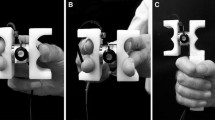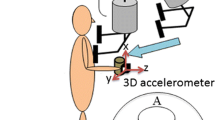Abstract.
The present study examined whether movement characteristics of individuals with spastic hemiparesis could be accounted for by disorders in movement planning. Two experiments were performed that tested minimisation of postural discomfort and minimisation of movement costs as constraints on grip selection. In the 1st experiment, spastic subjects and controls had to pick up a bar and place it in one of 5 boxes with either the left or right side down. In addition, awkwardness ratings of the different postures were given. Minimisation of posture discomfort as constraint on grip selection was examined. In line with previous studies, grip selection for the control subjects was based on minimisation of end posture discomfort. For the unimpaired hand of the spastic subjects, no discrimination was made in discomfort ratings among the different postures. Accordingly, with this hand, subjects showed no preference for a particular grip type. The posture ratings for the impaired hand were more varied both within and between spastic subjects, and minimisation of discomfort at either the start or end could not completely account for the grips chosen. Rather, the results suggest that minimisation of total posture discomfort acted as a constraint on grip selection for this hand. In the 2nd experiment, minimisation of total movement costs as a constraint on grip selection was tested. Spastic subjects and a control group had to grasp a bar on a clockface and rotate one end to the top position, starting from 15 different starting positions. Again, the end-state comfort effect was demonstrated in the control group. For the impaired hand of the spastic subjects, minimisation of total movement costs as expressed by a reduction of the total amount of joint rotation was shown to account for the grips chosen. The lack of consistency in grip selection for the unimpaired hand at some starting positions seemed to stem from an unresolved conflict between minimisation of end posture discomfort and minimisation of total movement costs. The combined results of the two experiments suggest that grip planning in spastic hemiparetic subjects is not disturbed per se. Rather, different constraints are imposed during the grip selection process. If movements are difficult to execute (i.e. because the hand is impaired), grip planning proceeded by a minimisation of total movement costs by choosing a task solution that reduced the total amount of joint rotation.
Similar content being viewed by others
Author information
Authors and Affiliations
Additional information
Electronic Publication
Rights and permissions
About this article
Cite this article
Steenbergen, B., Hulstijn, W. & Dortmans, S. Constraints on grip selection in cerebral palsy. Exp Brain Res 134, 385–397 (2000). https://doi.org/10.1007/s002210000458
Received:
Accepted:
Published:
Issue Date:
DOI: https://doi.org/10.1007/s002210000458




